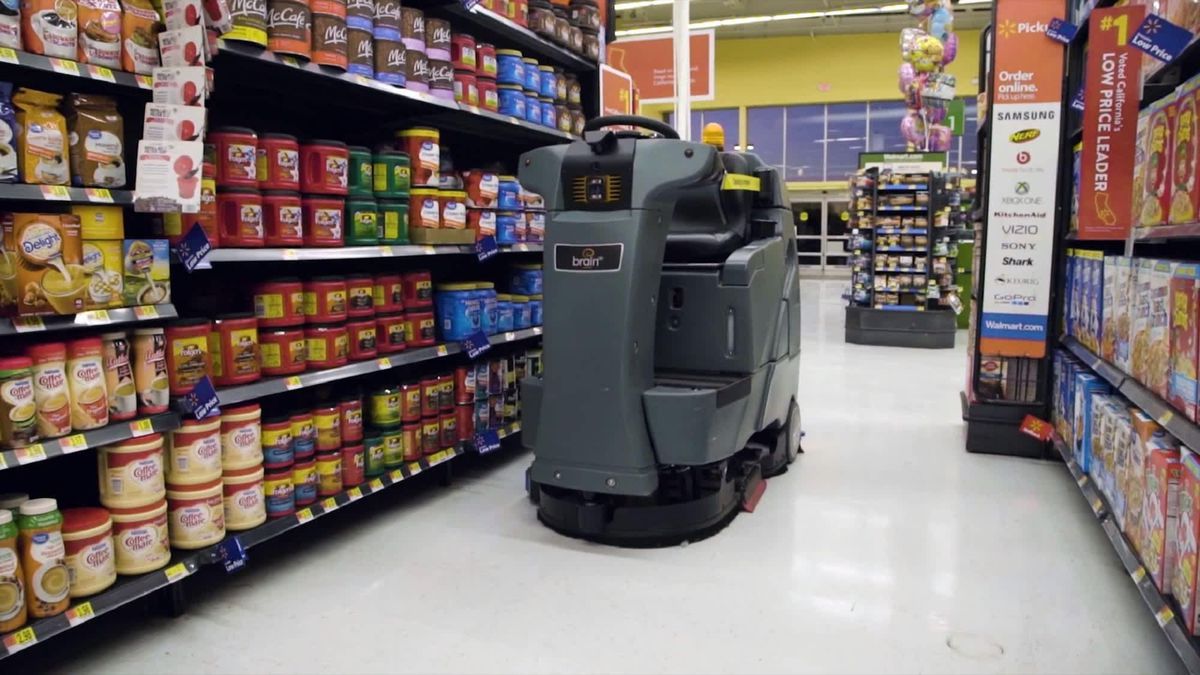In the tranquil town of Salem, N.H., shoppers at a Walmart Superstore are witnessing the future of grocery shopping. This isn’t your typical grocery visit where customers stroll through colorful aisles picking up produce and essentials for the week. Instead, behind a windowless concrete wall lies a glimpse of what could become the new norm: a collaboration between humans and robots to fulfill online grocery orders.
Welcome to Walmart’s “micro-fulfillment center”—a 20,000-square-foot hybrid of technological prowess and human touch. This state-of-the-art setup, developed in partnership with robotics engineering firm Alert Innovation, is designed to help Walmart keep up with the ever-increasing demand for online grocery shopping. Their secret weapon? An army of small wheeled robots known as Alphabot.
So, what exactly does Alphabot do? Imagine an intricate maze of long steel rails intertwined with three-story high shelves, each meticulously organized with everyday grocery items, from mustard to frozen peas. Gliding effortlessly between these shelves are the Alphabot robots. With their maneuverable, geared wheels, these robots can find and collect items from any shelf—whether it’s on the ground floor or the top level.
At the heart of the operation, each robot locates the right bin, retrieves it, and delivers it to a Walmart worker standing at a packing station. It’s a seamless exchange: the worker removes the required item from the bin and places it into grocery bags. The filled bin is then transported to another station where it’s loaded onto a cart, ready to be wheeled out to a waiting shopper’s car.
This blend of machine efficiency and human oversight is more than just a cool innovation—it’s a solution to a pressing problem in the retail industry. Walmart’s senior manager of pickup automation, Brian Roth, noted that traditional methods cause significant congestion with clerks cluttering aisles as they collect orders. By shifting this activity to the back room with Alphabot, Walmart is not only boosting efficiency but also enhancing the shopping experience for those who still prefer to browse the aisles themselves.
Walmart’s initial foray into this technology began in 2016, culminating in the launch of the first Alphabot-driven fulfillment center in March of the previous year. However, this robotic system represents only a fraction of the store’s operational capacity, currently handling around 20% of online orders. Expansion plans are already in place, with sites in Mustang, Oklahoma, and Burbank, California, next in line for Alphabot integration.
The wave of interest in online grocery shopping and fulfillment solutions isn’t exclusive to Walmart. Competitors such as Ahold Delhaize, the parent company of Stop & Shop, and Albertsons have deployed similar systems, often partnering with other robotics firms like Takeoff Technologies.
Food industry expert, Barry Friends, from the consulting firm Pentallect, captures the essence of this industry-wide movement. He attributes the rapid growth in online grocery ordering—valued at $20 billion last year and anticipated to grow by 18% annually—to the convenience it offers. The popular “click-and-pick” services, where customers order online and pick up in-store, have particularly resonated with busy families. Working mothers, for instance, appreciate the simplicity it brings, keeping their children comfortably strapped in their car seats as they collect their groceries effortlessly.
Innovation in grocery fulfillment continues to thrive not just in Salem but worldwide. Companies such as Dematic, Fabric, and the United Kingdom’s Ocado Group are all vying for a share of the market, continually developing advanced systems to further streamline the grocery shopping experience. These technologies promise not only efficiency but also the ability to handle and scale large volumes of various consumer goods.
During a recent visit to Salem, one could witness the scope of what Alphabot was designed to achieve. With only 30 robots currently in operation, the setup can handle approximately 4,500 items. However, the system is structured to expand significantly. John Lert, the founder of Alert Innovation, mentioned the facility’s ability to accommodate up to 100 robots and a broad inventory of 20,000 different products. His reflections on the micro-fulfillment center evoke a nostalgic sentiment, likening it to the early 20th century when store clerks fetched items for customers directly, long before the advent of self-service retail.
The journey of adapting technology to the ever-evolving demands of consumers remains both challenging and fascinating. Friends commented, “It still is very small as a percentage of the whole pie, but it’s growing quickly.” And indeed, as the demands for convenient, efficient, and fast shopping solutions increase, so too will the sophistication of the technologies employed.
One thing is for sure—whether it’s from the comfort of our homes or via the swift precision of robots, the way we shop for groceries is undergoing a significant transformation. As Walmart and other major retailers navigate this new terrain, they will likely continue to push the boundaries of what’s possible, reshaping the shopping landscape once again.
The integration of these cutting-edge technologies into everyday shopping experiences hints at a future where convenience doesn’t compromise quality or service. And as shoppers adapt to these changes, the retail sector stands at the cusp of yet another revolutionary shift, driven by innovation, competition, and the timeless quest for efficiency.
Give Feedback. How was this article?
You can help us improve by leaving feedback specific to
this content.
Which of the following feelings did this article evoke in
you?
Multiple Selection
How would you rate the quality of this article?
How easy was it for you to find the information you were
looking for in this article?
Super Hard😱
😎Super Easy
We use Artificial Intelligence to help bring you the best
articles possible. What percentage of this article do you think was written by AI?
How can we improve this article (or our articles in
general)?
Do you have any other suggestions for improving our content
or
website?
Thanks for the feedback
Thank you for supporting us to improve ourselves with your
feedback.

